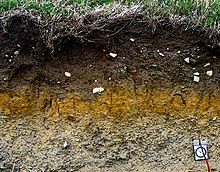Stagnogley


A stagnogley soil is a type of non-alluvial, non-calcareous soil that is typically loamy or clayey soil with a dense, impervious, subsurface horizon.[1] Stagnogley soils are related to the pseudogleys and are classified as gleyic soils. The name "stagnogley" comes from the soil's gley dynamics. This hygroscopic soil is nutrient-poor, often highly acidic, and poorly aerated, making it unsuitable for farming due to poor crop growth.[2] With a shallow topsoil layer and a moderately stony subsoil, [3] stagnogley soil is mainly used for woodland,[4] supporting tree species that thrive well in these conditions, such as the English Oak.
Formation
This type of soil, whose topsoil becomes bleached due to continual waterlogging, is often formed on sand-rich material over dense, sandy-loamy to silty-clayey subsoil—also called Sandkerf in German—in cool, moist climatic zones. As a result of frequent waterlogging throughout the seasons at low temperatures, minerals like iron and magnesium are released and deposited in the sandy topsoil to the sides. Where the soil is saturated all-year round, it turns into bog stagnogley and, eventually, into bog.[2] Examples, known as missen occur in the Black Forest in Germany.
Extent
Stagnogley soils occur in perhumid climates and also on steep slopes. They are found, for example, in the central European Central Upland ranges of the Black Forest, Ore Mountains and Eifel in waterlogged places, as well as on the Midvale Ridge in the UK. Due to the discharge of heavy metals, they occur with oxigleys.[2]
References
- ^ Whittow, John (1984). Dictionary of Physical Geography. London: Penguin, 1984, p. 507. ISBN 0-14-051094-X.
- ^ a b c Fritz Scheffer, Paul Schachtschabel: Lehrbuch der Bodenkunde. 15th edn., newly revised and expanded by Hans-Peter Blume. Spektrum, Heidelberg, etc., 2002, ISBN 3-8274-1324-9.
- ^ BofaWeb[permanent dead link], Landesanstalt für Umwelt, Messungen und Naturschutz Baden-Württemberg, accessed on 1 August 2008
- ^ Stagnogley in: Microsoft Encarta
- v
- t
- e
for Soil Resources (1998–)
- Acrisols
- Alisols
- Andosols
- Anthrosols
- Arenosols
- Calcisols
- Cambisols
- Chernozem
- Cryosols
- Durisols
- Ferralsols
- Fluvisols
- Gleysols
- Gypsisols
- Histosol
- Kastanozems
- Leptosols
- Lixisols
- Luvisols
- Nitisols
- Phaeozems
- Planosols
- Plinthosols
- Podzols
- Regosols
- Retisols
- Solonchaks
- Solonetz
- Stagnosol
- Technosols
- Umbrisols
- Vertisols
- FAO soil classification (1974–1998)
- Unified Soil Classification System
- AASHTO Soil Classification System
- Référentiel pédologique (French classification system)
- Canadian system of soil classification
- Australian Soil Classification
- Polish Soil Classification
- 1938 USDA soil taxonomy
- List of U.S. state soils
- List of vineyard soil types
- Sand
- Silt
- Clay
- Loam
- Topsoil
- Subsoil
- Soil crust
- Claypan
- Hardpan
- Gypcrust
- Caliche
- Parent material
- Pedosphere
- Laimosphere
- Rhizosphere
- Bulk soil
- Alkali soil
- Bay mud
- Blue goo
- Brickearth
- Brown earth
- Calcareous grassland
- Dark earth
- Dry quicksand
- Duplex soil
- Eluvium
- Expansive clay
- Fill dirt
- Fuller's earth
- Hydrophobic soil
- Loess
- Lunar soil
- Martian soil
- Mud
- Muskeg
- Paleosol
- Peat
- Prime farmland
- Quicksand
- Serpentine soil
- Spodic soil
- Stagnogley
- Subaqueous soil
- Takir
- Terra preta
- Terra rossa
- Tropical peat
- Yedoma
 Types of soil
Types of soil










